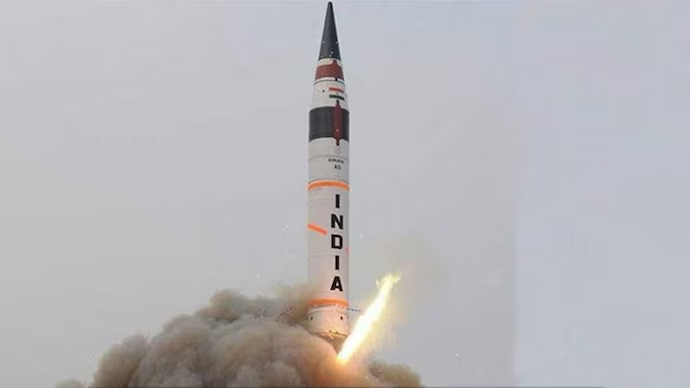| In Short |
| · India successfully launched the Agni-4 missile from Odisha’s Integrated Test Range, validating all technical parameters |
| · Agni-4 has a range of 4,000 km and can carry nuclear warheads, strengthening India’s long-range strike capabilities |
| · This test enhances India’s strategic deterrence, with a focus on its second-strike capabilities in the region |
| · It follows other missile advancements, like the Agni-Prime and Agni-5, showcasing India’s growing defense technology |
| · The test was overseen by the Strategic Forces Command, demonstrating operational readiness |
The Agni-4 ballistic missile was launched successfully on September 6, 2024, marking another major achievement within the nation’s strategic defence capabilities. The 4,000-kilometer-strike-range ballistic missile is an intermediate-range one and was tested at ITR Chandipur in Odisha. The launch, under the aegis of the Strategic Forces Command, met all the operational and technological parameters required for successful validation, marking a long leap within the nation’s missile capability and strategic deterrence capability.
Agni-4 Ballistic Missile:
Key Features and Capabilities Agni-4 is part of a powerful Indian missile program for strategic long-distance defense. Equipped with nuclear warheads, this surface-to-surface missile entrenches India as a nuclear power to reckon with in the region. It can reach as far as 4,000 kilometers away, hence having the capacity to strike deep into adversary territories in Asia.

This test is a pointer not only to the operational preparedness of the missile but also to the growing capabilities of India in missile technology. The Agni-4 is seen as a key component in India’s nuclear deterrent, which has been conceptualized to provide the security of the nation through a gradually deteriorating geopolitical environment.
Agni-4 Test: Strategic Relevance
The successful test of Agni-4 comes at a time when India is placing emphasis on strengthening its defense and deterrence capabilities. As missile technology acquires greater significance in modern-day warfare, the ability of India to deploy long-range ballistic missiles such as Agni-4 adds an edge to its defense posture. This also enhances India’s second-strike capability-a very vital component of the country’s nuclear doctrine, whose bedrock lies in the basic principles of credible minimum deterrence.

As one member of a series of Agni missiles, Agni-4 is supposed to provide strategic depth to India’s nuclear arsenal. The most impressive range of this missile covers almost all of China, a key consideration given regional security dynamics. In addition to this, high accuracy and capacity for warheads are critical in ensuring that India will be in a position to effectively respond to any potential threats.
Recent Developments in India’s Missile Program
The Agni-4 test follows a string of significant strides that India has been taking in its missile program. Early this year, the country successfully launched Agni-Prime – a new generation of missiles that is more accurate but lighter in weight. Agni-Prime has a range of 1,000 to 2,000 kilometers and extends variability for shorter-range strikes within India’s missile arsenal.
India also tested the Agni-5 missile, extending the country’s strike capability to over 5,000 km. The Agni-5 is equipped with MIRV, allowing one missile to carry and deploy multiple warheads at different targets. A development like this has established India as an emerging missile power that is well-capable and prepared to challenge any adversary with advanced defense systems.
Improvement of India’s Defence Capabilities
The success of the Agni-4 test underlines the growing confidence of India in its indigenous missile technology. Conducted under the supervision of the Strategic Forces Command, this test signals that India is well-prepared to defend its sovereignty and maintain peace in the region through strategic deterrence.
Furthermore, the test on Agni-4 serves as a good reminder about the country’s commitment to modernize its defense infrastructure against the dynamics of change happening across the globe. Since improvements in missile technology are becoming increasingly essential to national security, concentration by India on long-range missile systems reflects a strategic step that is likely to leave lasting legacies in its defense policy.
Conclusion
The successful test of Agni-4 is a big achievement for India, which seals its position as a strong player in defense on the world platform. The capability to carry nuclear warheads and a 4,000-kilometer reach places this weapon in the category of being a cornerstone of nuclear deterrence for India. Since the country is consistently strengthening its defense, such tests will keep India at par in the international arena.
While the Indian defense sector is moving ahead at a very progressive scale, the successful test of Agni-4 is again proof of the commitment by India in developing strategic capabilities. While India continuously invests in high-technology defense armaments, its capability to defend its borders and also to ensure regional stability remains as strong as ever.
For Latest News Updates Click Here
